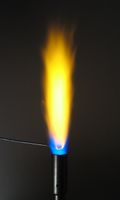Sodium
Sodium is a chemical element with an atomic number of 11. Its symbol is Na (from its Latin name natrium). It is an alkali metal. Although sodium has many isotopes, most decay in a short time. Because of this, all sodium in nature (mainly found in seawater) is of the isotope 11Na23. The atomic mass of sodium is 22.9898.
 | |||||||||||||||||||||
| General properties | |||||||||||||||||||||
|---|---|---|---|---|---|---|---|---|---|---|---|---|---|---|---|---|---|---|---|---|---|
| Appearance | silvery white metallic | ||||||||||||||||||||
| Standard atomic weight (Ar, standard) | 22.98976928(2)[1] | ||||||||||||||||||||
| Sodium in the periodic table | |||||||||||||||||||||
| |||||||||||||||||||||
| Atomic number (Z) | 11 | ||||||||||||||||||||
| Group | group 1 (alkali metals) | ||||||||||||||||||||
| Period | period 3 | ||||||||||||||||||||
| Block | s-block | ||||||||||||||||||||
| Element category | alkali metal | ||||||||||||||||||||
| Electron configuration | [Ne] 3s1 | ||||||||||||||||||||
Electrons per shell | 2, 8, 1 | ||||||||||||||||||||
| Physical properties | |||||||||||||||||||||
| Phase at STP | Na: Solid | ||||||||||||||||||||
| Melting point | 370.944 K (97.794 °C, 208.029 °F) | ||||||||||||||||||||
| Boiling point | 1156.090 K (882.940 °C, 1621.292 °F) | ||||||||||||||||||||
| Density (near r.t.) | 0.968 g/cm3 | ||||||||||||||||||||
| when liquid (at m.p.) | 0.927 g/cm3 | ||||||||||||||||||||
| Critical point | 2573 K, 35 MPa (extrapolated) | ||||||||||||||||||||
| Heat of fusion | 2.60 kJ/mol | ||||||||||||||||||||
| Heat of vaporization | 97.42 kJ/mol | ||||||||||||||||||||
| Molar heat capacity | 28.230 J/(mol·K) | ||||||||||||||||||||
Vapor pressure
| |||||||||||||||||||||
| Atomic properties | |||||||||||||||||||||
| Oxidation states | −1, +1 (a strongly basic oxide) | ||||||||||||||||||||
| Electronegativity | Pauling scale: 0.93 | ||||||||||||||||||||
| Ionization energies |
| ||||||||||||||||||||
| Atomic radius | empirical: 186 pm | ||||||||||||||||||||
| Covalent radius | 166±9 pm | ||||||||||||||||||||
| Van der Waals radius | 227 pm | ||||||||||||||||||||
| Spectral lines of sodium | |||||||||||||||||||||
| Other properties | |||||||||||||||||||||
| Natural occurrence | Na: Primordial | ||||||||||||||||||||
| Crystal structure | body-centered cubic (bcc) | ||||||||||||||||||||
| Speed of sound thin rod | 3200 m/s (at 20 °C) | ||||||||||||||||||||
| Thermal expansion | 71 µm/(m·K) (at 25 °C) | ||||||||||||||||||||
| Thermal conductivity | 142 W/(m·K) | ||||||||||||||||||||
| Electrical resistivity | 47.7 nΩ·m (at 20 °C) | ||||||||||||||||||||
| Magnetic ordering | paramagnetic[2] | ||||||||||||||||||||
| Magnetic susceptibility | +16.0·10−6 cm3/mol (298 K)[3] | ||||||||||||||||||||
| Young's modulus | 10 GPa | ||||||||||||||||||||
| Shear modulus | 3.3 GPa | ||||||||||||||||||||
| Bulk modulus | 6.3 GPa | ||||||||||||||||||||
| Mohs hardness | 0.5 | ||||||||||||||||||||
| Brinell hardness | 0.69 MPa | ||||||||||||||||||||
| CAS Number | 7440-23-5 | ||||||||||||||||||||
| History | |||||||||||||||||||||
| Discovery and first isolation | Humphry Davy (1807) | ||||||||||||||||||||
| Main isotopes of sodium | |||||||||||||||||||||
| |||||||||||||||||||||
Properties
Sodium is a light-weight, silver-colored metal. Sodium is soft. It can easily be cut with a knife. When someone cuts it, the exposed part will become white over time. It reacts with air to form, at first sodium oxide, then slowly sodium hydroxide and sodium carbonate. Sodium is a little less dense than water. It floats and reacts instantly with water, producing hydrogen and sodium hydroxide. This reaction makes a lot of heat, usually causing the hydrogen to light on fire. When this happens, sodium melts because of its low melting point. Sodium is highly reactive because it has one valence electron, which is easily removed.
Compared with other alkali metals, sodium is less reactive than potassium and more reactive than lithium.[4]
Chemical compounds
These are chemical compounds that contain sodium ions. Sodium only exists in one oxidation state: +1.
- Sodium aluminum fluoride, used to make aluminum
- Sodium amide, very strong base
- Sodium arsenite, colorless solid, very toxic
- Sodium arsenate, oxidizing agent, very toxic
- Sodium azide, used in airbags
- Sodium bicarbonate, baking soda, used in cooking
- Sodium bismuthate, oxidizing agent, used to test for manganese
- Sodium bisulfate, acidic, used to lower pH
- Sodium bromate, oxidizing agent, used to dye hair
- Sodium bromide, rare, used in some medicine
- Sodium carbonate, used to make glass
- Sodium chlorate, used in some explosives
- Sodium chlorite, used in disinfectants
- Sodium chloride, table salt
- Sodium chromate, yellow, oxidizing agent, toxic
- Sodium dichromate, orange, oxidizing agent, toxic
- Sodium fluoride, used in toothpaste, bitter, toxic in large doses
- Sodium hydroxide, lye, used in soap, strong base
- Sodium hypochlorite, bleach, disinfectant
- Sodium hypophosphite, reducing agent, poisonous
- Sodium iodate, oxidizing agent, prevents iodine deficiency
- Sodium iodide, a weak reducing agent, prevents iodine deficiency
- Sodium manganate, rare green solid
- Sodium nitrate, used in blasting powder
- Sodium nitrite, used in food preservation
- Sodium periodate, oxidizing agent
- Sodium permanganate, less common than potassium permanganate, oxidizing agent
- Sodium phosphate, various uses
- Sodium phosphide, catalyst, used to speed up chemical reactions
- Sodium phosphite, toxic, reducing agent
- Sodium selenate, strong oxidizing agent, other selenium compounds
- Sodium selenide, strong reducing agent, reactive
- Sodium selenite, weak oxidizing agent, vitamin supplement
- Sodium sulfate, bitter, laxative
- Sodium sulfite, a weak reducing agent, used to preserve dried food
- Sodium tellurate, strong oxidizing agent
- Sodium telluride, a strong reducing agent, reacts with air easily
- Sodium tellurite, main tellurite compound
Discovery and name origins
Sodium was discovered by Sir Humphrey Davy, an English scientist, in 1807. He created it by electrolyzing sodium hydroxide. Davy named the element after soda[disambiguation needed], a name for sodium hydroxide or sodium carbonate.
Uses
Scientists can use it in the creation of organic compounds. It is used in orange streetlights and lamps that emit ultraviolet light.
Sodium compounds are used in soaps, toothpaste, baking, and antacids.
The human body needs sodium ions, taken in the form of sodium chloride, to live. Too much of it can cause health problems. Many organisms in the ocean depend on the concentration of sodium ions in water to survive.
Occurrence and production
Sodium does not occur as an element in nature, because it is not stable enough. It exists only in chemical compounds. Sodium ions are found in the ocean and in the Earth's crust.
Sodium is normally made by electrolysis of sodium chloride, which is mined from the Earth's crust.
SodiumChemical Compounds Media
Emission spectrum for sodium, showing the D line
A positive flame test for sodium has a bright yellow color.
The structure of sodium chloride, showing octahedral coordination around Na+ and Cl− centres. This framework disintegrates when dissolved in water and reassembles when the water evaporates.
Two equivalent images of the chemical structure of sodium stearate, a typical soap
The structure of the complex of sodium (Na+, shown in yellow) and the antibiotic monensin-A
Sodium-potassium alloy (NaK) phase diagram, showing the melting point of sodium as a function of potassium concentration. NaK with 77% potassium is eutectic and has the lowest melting point of the NaK alloys at −12.6 °C.
Related pages
- List of common elements
- Hyponatremia (a medical problem caused by not having enough sodium in the body)
References
- ↑ Meija, J.; Coplen, T. B.; Berglund, M.; Brand, W.A.; De Bièvre, P.; Gröning, M.; Holden, N.E.; Irrgeher, J.; Loss, R.D.; Walczyk, T.; Prohaska, T. (2016). "Atomic weights of the elements 2013 (IUPAC Technical Report)". Pure and Applied Chemistry. 88 (3): 265–91. doi:10.1515/pac-2015-0305.
{{cite journal}}: Unknown parameter|displayauthors=ignored (|display-authors=suggested) (help) - ↑ Magnetic susceptibility of the elements and inorganic compounds, in Lide, D. R., ed. (2005). CRC Handbook of Chemistry and Physics (86th ed.). Boca Raton (FL): CRC Press. ISBN 0-8493-0486-5.
- ↑ Weast, Robert (1984). CRC, Handbook of Chemistry and Physics. Boca Raton, Florida: Chemical Rubber Company Publishing. pp. E110. ISBN 0-8493-0464-4.
- ↑ De Leon, N. "Reactivity of Alkali Metals". Indiana University Northwest. Archived from the original on 2018-10-16. Retrieved 2007-12-07.






